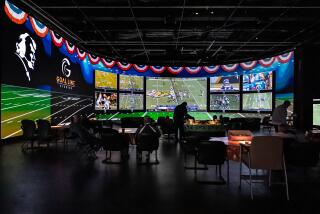Odds-On Favorite
- Share via
Over its 12-year history, the “Madden” franchise has pulled in more than $1 billion in revenue for its maker, Electronic Arts Inc., making it the most popular football video game ever. The franchise is so ubiquitous that it’s become the second-largest source of licensing income for the National Football League, after apparel.
Video games are unlikely to supplant live football in either revenue or fan base. But increasingly realistic and intelligent games blur the line between sport and simulation. Fox Television, for example, uses “Madden” to demonstrate plays during broadcasts of NFL games. NFL players spend hours at a time tossing virtual footballs after they’re through practicing the real thing.
For some football fans, particularly younger viewers, the video game is more engaging than the real thing. So for the NFL, “Madden” and other licensed games such as Sega Corp.’s “NFL2K” have become not only a convenient and reliable source of revenue, but also an important tool for cultivating new generations of fans.
“That’s one thing pro football has to watch out for--they’re not getting young kids,” said John Madden, the colorful TV commentator and former Raiders coach who agreed to lend his name and expertise to the franchise in 1986.
“If you get a kid, say between 8 and 15, he’ll be more of a video game fan than a fan of football,” Madden said. “It used to be that kids learned about football by playing it in the park or in their backyard. Now kids learn about it by playing the video game.”
That’s certainly true for Russ Beaudin and his 9-year-old son, Grey.
“He likes to watch the real sport on TV and immediately afterward play the video game,” said Beaudin, an Oakland architect. “It’s like he’s comparing notes. It’s definitely improved his understanding and participation in the sport.”
Making a credible football game is not easy, and the field is littered with failed attempts. At best, a game would rocket to the top of the charts one year, but fail to score the next. Only two studios have consistently put out hit games: --Visual Concepts of San Rafael, Calif., which develops the “NFL2K” series; and Electronic Arts Tiburon, which makes “Madden.”
The process is grueling and labor-intensive. Every NFL player must be accurately depicted, right down to his facial hairs. Each team has its own playbook programmed with dozens of signature plays, and each play has hundreds of variations. Actual stadiums are modeled into the games, and even the fields’ turf types affect how the football bounces. Uniforms get muddier as the game progresses.
The animation and the environments are so lifelike that it’s not uncommon for people to mistake the video game for a TV broadcast. Put it all together, and the video game sometimes can be as engrossing as the real one.
“Every year, it gets more realistic,” said Johnnie Morton, a wide receiver for the Detroit Lions and an avid video-game player. Like most players, Morton plays himself in the games. “At first, the characters were almost cartoonish. Now their facial expressions change. There are wrinkles in their jerseys. They get injured. It’s almost like the real thing.”
Madden recalls a time in San Francisco when a Philadelphia Eagles player rushed into a hotel room asking, “Where’s Madden?” When people pointed to the Fox commentator, the player said, “No, not that Madden. I want the game!”
Football video games haven’t always been sophisticated. In the 1980s, stick figures were the norm. Then in 1986, Electronic Arts founder Trip Hawkins talked John Madden into working on a video game. Because Madden disliked flying, Hawkins worked with him during a series of train rides as the announcer traveled between games.
The result was “John Madden Football,” released in 1989 for the Apple II computer. Since then, each successive game has sported ever-greater graphical and technological improvements.
In 1994, EA hired Visual Concepts to make a version of “Madden” for the Nintendo Super NES console. In 1996, Visual Concepts decided to make its own football game and developed “NFL2K” for Sega’s now-discontinued Dreamcast console.
Its debut in 1999 elicited kudos from fans for its rich game play, and its ultra-realistic graphics drew double-takes from people who had never played video games. Sega has sold more than 2 million copies of the “NFL2K” series. “Madden” is critical to the business of EA, the world’s largest independent game publisher. In 2001, sales of “Madden” games totaled more than $186million, up from $64million in 1995, according to Credit Suisse First Boston. Not bad for a title that costs $5million to $10million each year to develop.
That figure, of course, does not cover marketing and licensing costs. The NFL takes a percentage of retail sales (typically 5% to 10% of gross sales), as does Madden himself. Console manufacturers also get a slice, generally $5 to $7 for every disc sold. In December, the average retail price for “Madden 2002” was $48, according to NPDFunworld, a market research firm in New York.
EA still earns a substantial profit margin on the title, which accounts for 10% to 15% of the Redwood City, Calif., company’s annual revenue, according to EA President John Riccitiello. Year after year, millions of game players buy new copies of “Madden” to get the latest NFL player rosters and team statistics, ensuring a rock-steady stream of sales for EA.
“It’s a very profitable business,” Riccitiello said. “It’s not an extraordinarily expensive game to produce, but it is an extraordinary game.”
*
Alex Pham covers the video game industry. She can be reached at alex.pham@latimes.com.
More to Read
Go beyond the scoreboard
Get the latest on L.A.'s teams in the daily Sports Report newsletter.
You may occasionally receive promotional content from the Los Angeles Times.










